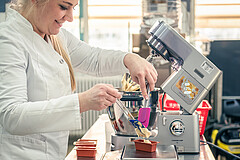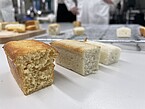Detail view
Finally delicious: New proteins to revolutionize gluten-free baked goods [24.05.23]
Daisies, peas, canola, etc.: Researchers at the University of Hohenheim want to replace gluten protein with new alternatives. Instead of ovens, 3-D printers would be possible VIDEO of the research project: www.youtube.com/watch
Gluten is one of the largest natural proteins and has fantastic properties: It keeps a well-cooked dough airy until baking stabilizes the open-pore structure. Prof. Dr. Mario Jekle from the University of Hohenheim in Stuttgart is working on processes in which selected proteins from peas, rapeseed, rice, or maize, for example, directly replace gluten protein or can be linked to form chains with gluten-like properties. Saponins from daisies and quinoa seeds or mucilages from cereal hulls additionally support the formation of an airy dough – and in some cases enrich it with valuable dietary fiber. The result can be put in the oven – or printed out in the 3-D printer in an energy-saving way and with many additional options. VIDEO of the research project: www.youtube.com/watch
The rolls that are currently coming off the production line at the Technical Center for Food Science are still small. The baked goods, which Natalie Feller portions onto the hand-width conveyor belt in small silicone box molds, each contain 30 grams of dough and are just about the size of a model train car.
The mini-rolls are steamed with moisture for a good two meters. This is followed by two more meters in the continuous baking oven. At the end of the mini-baking line, the test loaves come back to into light, golden and steaming.
Feller is a doctoral candidate at the University of Hohenheim’s Department of Plant-Based Foods. Her goal for the day is to make the fluffiest bread possible. To do this, she moved from the lab to the Technical Center. Here, the food scientists at the University of Hohenheim have at their disposal a complete range of equipment, such as that used in the bakery trade, dairies, or butcher stores.
Gluten proves to be a problematic protein in about 2% to 3% of the population
Feller’s baking experiment combines many things: food technology with materials science and engineering. The special challenge in this experiment is the recipe, as the dough is completely gluten-free and should still produce fluffy and tasty baked goods.
This is because gluten is a problematic protein for about 2% to 3% of the population. "We now know three disease patterns that are related to gluten," said Prof. Dr. med. Stephan Bischoff of the Institute of Clinical Nutrition at the University of Hohenheim.
The best known is celiac disease, a mixture of an allergy and autoimmune disease. He noted that wheat allergy, which is triggered by gluten and similar peptides, is similarly widespread. In addition, there is a third clinical picture, wheat sensitivity, which has been the least researched to date. "It is not yet clear exactly what triggers wheat sensitivity and whether gluten also plays a role in this case. At our department, we are therefore working hard on this puzzle."
Especially patients suffering from celiac disease have only one remedy in everyday life: to resort to gluten-free foods.
In classic baked goods, gluten serves as a supporting framework
In chemical-physical terms, however, gluten is a key protein, said Prof. Dr. Mario Jekle, head of the Department of Plant-Based Foods. "Gluten is not only one of the largest known proteins in the world. In baking, it has outstanding properties," said the food scientist.
In fact, you can think of a fully proofed dough as a kind of foam that solidifies during baking. The protein gluten gives structure to this foam and supports it so that it does not collapse prematurely.
This is exactly what many gluten-free baked goods lack: "Lathering up" the ingredients is not a problem. This can be achieved by stirring or using yeast, baking powder, and other leavening agents, just as with the classic wheat flour dough. "What has been almost impossible to do so far is to keep the many small gas bubbles in the dough without the supporting gluten scaffold."
Protein chains from natural proteins may provide a solution
With their current research, the food researchers at the University of Hohenheim are therefore taking a new approach: "Instead of supporting the dough with gluten, we focus on stabilizing the interface between gas bubbles and dough with alternative proteins," said Prof. Dr. Jekle.
To this end, the scientists are using new, tailor-made proteins. The starting materials are natural proteins from peas or rapeseed, from which the food scientist extracts the optimal proteins.
The new protein alternatives are supported by natural saponins. These are obtained from quinoa seeds – or from, stems, leaves, and flowers of daisies.
Prof. Dr. Jekle sees further potential in plant breeding: "If we define the requirements precisely, we can work with plant breeding to target new pea varieties whose proteins are even better suited to our approach."
Second approach provides additional dietary fiber
In another approach, the department is trying to chain natural proteins from rice, maize, or oats with mucins, referred to as arabinoxylans. These mucilages are found in almost all cereal hulls, which are also used as bran or cattle feed.
It is an approach with additional benefits because Prof. Dr. Jekle's working group can use these to enrich baked goods with valuable dietary fiber. Their importance is also emphasized by clinical nutritionist Prof. Dr. Bischoff from the University of Hohenheim. "To give an example: thirty grams of fiber a day is already good prevention against colon cancer, one of the three most common cancers in men and women."
The food scientists at the University of Hohenheim are therefore planning to investigate the use of arabinoxylans in other foods as well – for example, in meat substitutes. The exciting part: the approach not only enables substitute products with a meat-like structure, the dietary fiber also gives them a rather unique additional benefit. So far, there are no comparable products on the market.
In the near future, bread could also come from the 3D printer
Another vision is to perform the loosening of the dough and the baking process in one step – with the help of 3-D printers. For this, a nozzle builds up the pastry together with the pores in millimeter-thin layers. Above it a baking unit is placed, which immediately solidifies each layer.
The process is thus somewhat similar to the way Salzwedel bakers have been baking the classic Baumkuchen for 200 years. Here, too, the dough is applied in millimeter-thin layers and fixed in a more traditional manner over an open fire. "However, our technology at the University of Hohenheim is of course much more sophisticated, flexible, and can build many different structures," said Prof. Dr. Jekle.
For him, the 3D printer is almost a standard piece of equipment, and he has been experimenting with it for several years. Whether it's baked goods, meat, meat substitutes, or side dishes – in principle, almost any food could also be produced from the individual components in a 3D printer, he believes.
As a complement to the classic kitchen, the 3D food printer brings two more advantages: "With printed foods, I can personalize meals, meaning I can tailor the ratio of fats, carbohydrates, proteins, and all other components to exactly meet the personal needs of individuals. And I can also obtain some of the raw materials from residual materials that are created during food production, for example."
BACKGROUND: Protein research at the University of Hohenheim
Proteins are one of the most exciting and versatile components of nutrition and of any living organism. They are constantly being transformed, built up, and broken down in humans, animals, and plants. Scientists only have a basic understanding of many of these processes. With an ever-growing world population, producing sufficient quantities of high-quality proteins is a multifaceted challenge for agriculture, the food industry, and nutritional science. Protein research at the University of Hohenheim is looking for solutions to minimize the impact on climate, the environment, and biodiversity in order to ensure food security and resource conservation. All this makes it a highly relevant challenge for agricultural, nutritional, food, economic, and social sciences.
BACKGROUND: Food Sciences Technical Center Innovative methods and processes for food production are researched and developed in the food science pilot plants at the University of Hohenheim. Equipment includes the Dairy for Research and Training, a grain technology facility including a kneader and industrial baking oven, a flavor distillation facility, a complete meat processing facility, the Teaching and Research Distillery, and a state-of-the-art, software-guided sensory lab for sensory evaluation of products. The focus is on optimizing raw materials, sustainable food processing, and food analysis and quality assurance to develop practical solutions for the food industry. The Technical Center offers both students and companies the opportunity to participate in research projects and benefit from the expertise of the University of Hohenheim.
Text: Klebs
Contact for press:
Prof. Dr.-Ing. Mario Jekle, University of Hohenheim, Department of Plant-Based Foods,
T +49 711 459-22314, E mario.jekle@uni-hohenheim.de
Natalie Feller, University of Hohenheim, Department of Plant-Based Foods,
T+49 711 459-22320, E natalie.feller@uni-hohenheim.de
Prof. Dr. med. Stephan C. Bischoff, University of Hohenheim, Institute of Clinical Nutrition,
T +49 711 459-24100, E bischoff.stephan@uni-hohenheim.de
Back to








